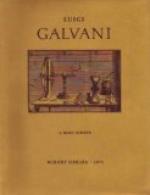|
This section contains 400 words (approx. 2 pages at 300 words per page) |
World of Health on Luigi Galvani
Luigi Galvani was not especially interested in electricity. At least, not at first. Born on September 9, 1737, at Bologna, Italy, Galvani was initially a student of theology; but he switched to the study of medicine, receiving his degree in 1762. In 1775 he was appointed Professor of Anatomy and Gynecology at the University of Bologna, the school from which he graduated.
In 1771, Galvani happened to observe the dissection of a frog and noticed the dead frog's legs would twitch when a spark touched them. This was no big surprise; it was known that live muscle tissue twitched when touched with a spark, so dead tissue ought to react the same way.
At first Galvani had no further interest in the incident, but later he recalled that a generation earlier Benjamin Franklin had shown lightning was an electrical phenomena. Galvani reasoned that if Franklin was right, lightning should have the same effect on a frog's legs as the spark. He set out to confirm Franklin's findings.
Galvani found that twitching did indeed occur during a thunderstorm. In fact, muscles could be made to twitch every time they came into contact with two different types of metal. Electricity was obviously involved, but was it coming from the muscle or the metal"
Keep in mind that Galvani was an anatomist. He decided that an "animal electricity" was responsible, and he published his findings in 1791. His paper, suggesting a different type of electric phenomena, received general acceptance; however, there were a few exceptions. Alessandro Volta was among those who disagreed with Galvani's conclusion. A spirited controversy erupted between the two. Volta ultimately prevailed, showing that the twitching was caused by the combination of the two different metals and the fluid within the muscle tissue.
Galvani was extremely disappointed. Worse, when he refused to swear allegiance to Napoleon Bonaparte's government in 1797, he lost his position at the university. He died in poverty on December 4, 1798.
Galvani is nonetheless remembered in a number of ways. A person who abruptly jumps into action is said to be galvanized. Iron that has had a layer of zinc crystals applied with electric current is known as galvanized iron. The steady flow of electricity that is created by the contact of two metals is known as galvanic electricity. Perhaps the best tribute to Galvani's memory came from André Ampère, who invented a device to measure current in 1820, the galvanometer.
|
This section contains 400 words (approx. 2 pages at 300 words per page) |


